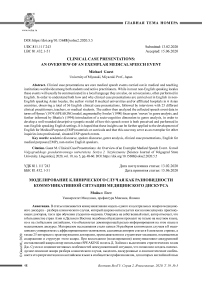Clinical case presentations: an overview of an exemplar medical speech event
Автор: Guest Michael
Журнал: Вестник Волгоградского государственного университета. Серия 2: Языкознание @jvolsu-linguistics
Рубрика: Главная тема номера
Статья в выпуске: 5 т.19, 2020 года.
Бесплатный доступ
Clinical case presentations are core medical speech events carried out in medical and teaching institutions worldwide among both students and active practitioners. While in most non-English speaking locales these events will usually be communicated in a local language they are also, on set occasions, often performed in English. In order to understand both how and why clinical case presentations are carried out in English in non- English speaking Asian locales, the author visited 8 medical universities and/or affiliated hospitals in 6 Asian countries, observing a total of 36 English clinical case presentations, followed by interviews with 25 different clinical practitioners, teachers, or medical students. The author then analyzed the collected speech event data in terms of Hymes’ (1974) SPEAKING model, augmented by Swales’ (1990) focus upon ‘moves’ in genre analysis, and further informed by Bhatia’s (1994) introduction of a socio-cognitive dimension to genre analysis, in order to develop a well-rounded descriptive synoptic model of how this speech event is both perceived and performed in non-English speaking English settings. It is hoped that these insights can be further applied to the development of English for Medical Purposes (EMP) materials or curricula and that this case may serve as an exemplar for other inquiries into professional, situated ESP speech events.
Academic discourse, spoken discourse, genre analysis, clinical case presentations, english for medical purposes (emp), non-native english speakers
Короткий адрес: https://sciup.org/149131596
IDR: 149131596 | УДК: 811.111’243 | DOI: 10.15688/jvolsu2.2020.5.5
Список литературы Clinical case presentations: an overview of an exemplar medical speech event
- Berkenkotter C., Huckin T., 1995. Genre Knowledge in Disciplinary Communication. Hillsdale, NJ, Lawrence Erlbaum. 195 p.
- Bhatia VK., 1993. Analyzing Genre: Language Use in Professional Settings. London, New York, Longman. 246 p.
- Bhatia V.K., 1994. Generic Integrity in Professional Discourse. Text and Talk in Professional Contexts, no. 6, pp. 61-76.
- Bhatia V.K., 2002. Applied Genre Analysis: Analytical Advances and Pedagogical Procedures. Johns A.M., ed. Genre in the Classroom: Multiple Perspectives. Mahwah, NJ, Erlbaum, pp. 279-283.
- Bhatia V.K., Bhatia A., 2007. Global Genres in Local Context. Linguistic Insights. Studies in Language and Communication, vol. 1 4, pp. 263-281.
- Boswood T., Marriot A. 1994. Ethnography for Specific Purposes: Teaching and Training in Parallel. English for Specific Purposes, vol. 13, iss. 1, pp. 3-21. DOI: 10.1016/0889-4906(94)90021-3.
- Couture B., 1986. Effective Ideation in Written Text: A Functional Approach to Clarity and Exigence. Couture B., ed. Functional Approaches to Writing: Research Perspectives. London, Frances Pinter, pp. 69-92.
- Dudley-Evans T., 1987. Introduction to Genre Analysis and ESP. ELR Journal, vol. l, pp. 27-39.
- Dudley-Evans T., 1993. Variation in Communication Patterns Between Discourse Communities: The Case of Highway Engineering and Plant Biology.
- Blue G.M., ed. Language Learning and Success: Studying Through English. London, Macmillan, pp. 141-147.
- Fairclough N., 1992. Discourse and Social Change. Cambridge, Polity. 259 p.
- Guest M., 2017. What are FAPs? And Why Should Medical Students Focus upon Them? Journal of Medical English Education, vol. 16, iss. 1, pp. 18-23.
- Guest M., 2018. Conferencing and Presentation English for Young Academics. Singapore, Springer. 238 p. DOI: https://doi.org/10.1007/978-981-13-247.
- Hart R.P., 1986. Of Genre, Computers and the Reagan Inaugural. Simons H., Aghazarian A., eds. Form, Genre and the Study of Political Discourse. Columbia, SC, University of South Carolina Press, pp. 278-298.
- Hopkins A., Dudley-Evans T., 1988. A Genre-Based Investigation of the Discussions Sections in Articles and Dissertation. English for Specific Purposes, vol. 7, iss. 2, pp. 113-121. DOI: 10.1016/ 0889-4906(88)90029-4.
- Hoey M., 1983. On the Surface of Discourse. London, George Allen and Unwin. 211 p.
- Hyland K., 1992. Genre Analysis: Just Another Fad? Forum, vol. 30, iss. 2, pp. 14-17.
- Hymes D.H., 1974. Foundations in Sociolinguistics: An Ethnographic Approach. Philadelphia, University of Pennsylvania Press. 260 p.
- Saville-Troike M., 1982. The Ethnology of Communication. Oxford, Oxford University Press. 338 p.
- Swales J., 1988. Discourse Communities, Genres and English as an International Language. World Englishes, vol. 7, iss. 2, pp. 211-220. DOI: https:/ /doi.org/10.1111/j.1467-971X. 1988.tb00232.x.
- Swales J., 1990. Genre Analysis: English in Academic and Research Settings. Cambridge, Cambridge University Press. 260 p.
- Van Dijk T.A., 1997. Introduction: The Study of Discourse. The Study of Discourse: A Multidisciplinary Introduction. Vol. 1. Discourse as Structure and Process. Thousand Oaks, CA, US, Sage Publications, Inc., pp. 1-34.
- Winter E.O., 1977. A Clause-Relational Approach to English Texts: A Study of Some Predictive Lexical Items in Written Discourse. Instructional Science, vol. 6, iss. 1, pp. 1-92. DOI: https:// doi.org/10.1007/BF0012559.


